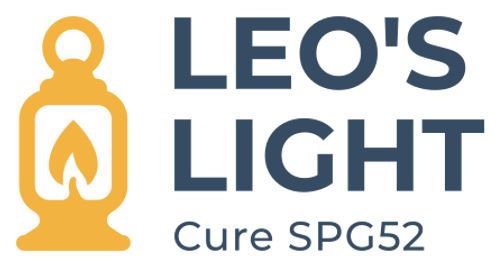Leo's Story
Leo arrived bright-eyed and perfect. I counted his fingers and toes, memorized the curve of his cheeks, and let myself believe that the world would be straightforward.

A few months later the quiet fear began. Leo struggled to roll and could not sit on his own. His head wobbled and his mouth stayed open, which meant constant drooling and bibs tucked into every bag and drawer.
Leo would be diagnosed with developmental delays and low muscle tone, and at 13 months he began weekly physical and occupational therapy. When he was introduced to solid foods, his low tone made chewing and swallowing difficult, so speech therapy was added to the regimen. I knew something more still seemed off... but three therapists every week became the routine and the source of hope.

By a year and a half the gaps were undeniable. Leo still could not crawl or walk, and his head growth had slowed, I met with a pediatric neurologist who ordered a brain MRI.
A few days before Christmas, the results came in. The scan showed polymicrogyria (an abnormal number of small, irregular brain folds) in the frontal and temporal lobes, a pattern that often is associated with seizures rather than low tone. Genetic testing would be needed to get a clearer answer.
On March 17, 2025, I received the genetic test results. Leo had Spastic Paraplegia 52…. a rare genetic disorder that I was told would give him a higher risk of seizures and significant speech and motor delays...and had no cure.
When you get news like that, there’s not much else to do but to keep going and pray for the best.... Therapies brought small, hard-won victories. Leo learned to sit up from lying down. He started to bear more weight through his legs with help. Every inch mattered - every little new sound was cause for a large celebration.
Then, a few days short of Leo’s second birthday, his first episode of seizures arrived. They were prolonged and perplexed the doctors. After a three day stay in the hospital he was discharged and the permanent deep seated fear set in of when it would happen again.

Then Leo’s Opi (grandfather) found a news article about emerging gene therapy efforts for this family of disorders, and that started a mad dash to read everything that I could find on the topic. What I learned through other families and researchers was terrifying… SPG52 also came with significant intellectual disabilities and was degenerative, which meant that without an effective treatment, Leo’s hard-won progress from therapy would eventually fade. He would most likely not develop normal speech and be in a wheelchair by high school. Words cannot describe the grief I experienced.
However, there was hope.
This also led to discovering the SPG52 research taking place in Spain at the Universitat Autònoma de Barcelona, where a dedicated team had already been working for six years to develop a gene therapy treatment. I knew this was the only shot at a cure for Leo.
SPG52 affects about 56 children worldwide. There is no commercial incentive for companies to fund development at this scale, so families carry the fundraising responsibility. Crowdfunding has already moved SPG52 forward at UAB, but we need to close the next, time-critical gap so Leo and peers are young enough to benefit when trials open.

